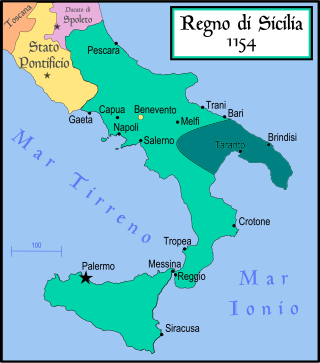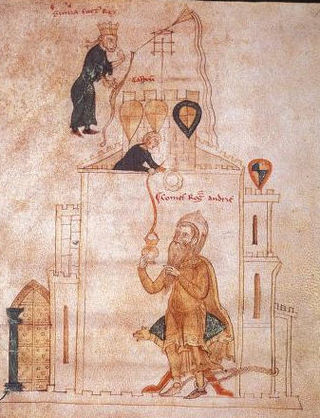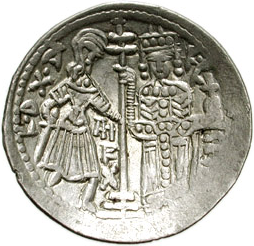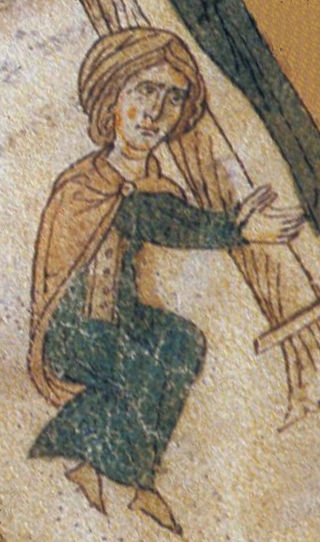
Robert Guiscard, also referred to as Robert de Hauteville, was a Norman adventurer remembered for his conquest of southern Italy and Sicily in the 11th century.

Tancred was King of Sicily from 1189 to 1194. He was born in Lecce, an illegitimate son of Roger III, Duke of Apulia by his mistress Emma, a daughter of Achard II, Count of Lecce. He inherited the title "Count of Lecce" from his grandfather and is consequently often referred to as Tancred of Lecce. Due to his short stature and unhandsome visage, he was mocked by his critics as "The Monkey King".

William I, called the Bad or the Wicked, was the second king of Sicily, ruling from his father's death in 1154 to his own in 1166. He was the fourth son of Roger II and Elvira of Castile.

William III, a scion of the Hauteville dynasty, was the last Norman King of Sicily, who reigned briefly for ten months in 1194. He was overthrown by his great-aunt Constance and her husband Emperor Henry VI.

Tancred of Hauteville was an 11th-century Norman petty lord. Little is known about him, and he is best remembered by the achievements of his twelve sons. Various legends arose about Tancred, but they have no supporting contemporary evidence that has survived the ages.

The Principality of Taranto was a state in southern Italy created in 1088 for Bohemond I, eldest son of Robert Guiscard, as part of the peace between him and his younger brother Roger Borsa after a dispute over the succession to the Duchy of Apulia.

Humphrey of Hauteville, also nicknamed Abelard, was the third Norman Count of Apulia. He succeeded his brother Drogo.
Matthew Bonnellus was a rich knight of an ancient and influential Norman family who became the lord of Caccamo in Sicily. He is most famous as the leader of three consecutive revolts against the ammiratus ammiratorum Maio of Bari and King William I of Sicily.

Roger, count of Andria and Great Chamberlain of Sicily, was a claimant for the Sicilian throne after the death of William II in 1189. He is claimed by some to have been a great-grandson of Drogo of Hauteville, but this cannot be proven.

Roger III was the eldest son of King Roger II of Sicily and Elvira of Castile. He was the Duke of Apulia from 1134 until his death.
Simon, bastard son of Roger II of Sicily, was declared Prince of Taranto by his father in 1148, on the death of Roger III, Duke of Apulia, the eldest legitimate son of Roger II.
Gilbert was a Norman Count of Gravina from 1159 until 1167. His father Bertrand was the illegitimate son of Rotrou III, Count of Perche. He was a cousin of Margaret of Navarre, the queen of Sicily. He arrived in Sicily sometime around 1159 and, through Margaret's influence, was created Count of Gravina in Apulia immediately.
Tancred of Conversano, the youngest son of Geoffrey, Count of Conversano, became the count of Brindisi on his father's death in 1100.

Sibylla of Acerra (1153–1205) was Queen of Sicily as the wife of King Tancred. After Tancred's death, she was regent in 1194 for their son, King William III. She was the sister of Count Richard of Acerra.

The House of Hauteville was a Norman family, originally of petty lords, from the Cotentin Peninsula in Normandy.

The Italo-Normans, or Siculo-Normans (Siculo-Normanni) when referring to Sicily and Southern Italy, are the Italian-born descendants of the first Norman conquerors to travel to Southern Italy in the first half of the eleventh century. While maintaining much of their distinctly Norman piety and customs of war, they were shaped by the diversity of Southern Italy, by the cultures and customs of the Greeks, Lombards, and Arabs in Sicily.
The County of Lecce was a county located in Apulia, in south-eastern Italy, which existed from 1055 until 1463. Its capital was at the city of Lecce, and it was bounded by the territories of Brindisi to the north, Oria and Nardò to the west, and Soleto and Otranto to the south.

The County of Apulia and Calabria, later the Duchy of Apulia and Calabria, was a Norman state founded by William of Hauteville in 1043, composed of the territories of Gargano, Capitanata, Apulia, Vulture, and most of Campania. It became a duchy when Robert Guiscard was raised to the rank of duke by Pope Nicholas II in 1059.

Henry VI, a member of the Hohenstaufen dynasty, was King of Germany from 1169 and Holy Roman Emperor from 1191 until his death. From 1194 he was also King of Sicily.
Robert of Lauro was the Count of Caserta, a powerful nobleman and administrator in the Kingdom of Sicily, "effectively the king's viceroy on the mainland" between 1171 and his death. He was a close colleague of Count Tancred of Lecce, the future king. His influence helped his cousin Roger become Archbishop of Benevento (1179–1225).











